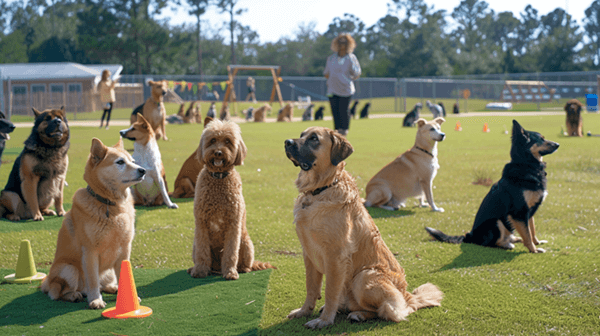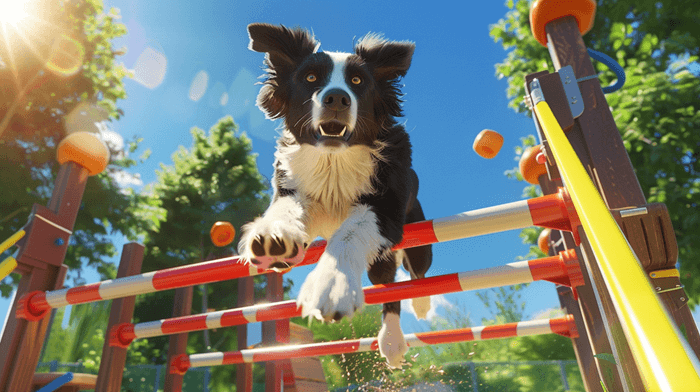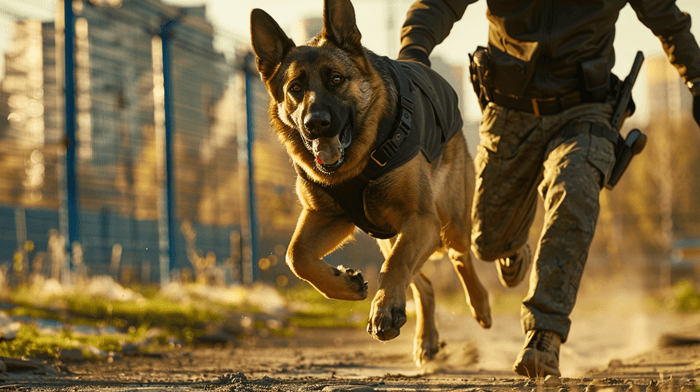
Discover Which Are the Most Intelligent and Obedient
Training a dog can be a rewarding experience, but the ease with which it’s achieved depends largely on the breed. Some dogs are naturally more responsive to training due to their intelligence and eagerness to please. If you’re looking for a breed that learns quickly and responds well to commands, this article is for you. Here, we present the 10 easiest dog breeds to train, based on their intelligence, obedience, and ability to learn quickly.
Choosing the right dog breed for training can make a world of difference, especially if you’re a first-time owner or have specific goals, like participating in dog sports or simply having a well-behaved pet. Not all breeds are created equal when it comes to their ability to learn, and while some dogs can pick up commands in a matter of minutes, others may need weeks of constant practice. So, which breeds excel in being easy to train?
In this article, you’ll discover the 10 easiest dog breeds to train, a selection that not only considers obedience but also their natural drive to work alongside humans. If you’re looking for a dog that’s easy to teach, these breeds will surprise you with their capacity to learn and adapt to different lifestyles. Plus, you’ll understand the factors that make these dogs so receptive to training and how you can make the most of their abilities.
Benefits of Choosing an Easy-to-Train Breed
Before diving into the list of breeds, it’s essential to understand why choosing an easy-to-train breed can be a significant advantage:
1. Saves Time and Effort
Training a dog can be a time-consuming process, but breeds that are easy to train tend to pick up commands quickly, which reduces the amount of time and effort you’ll need to invest. Intelligent and obedient dogs often learn basic commands like «sit,» «stay,» and «come» in just a few repetitions, making their education and day-to-day management easier.
2. Less Frustration for Owners
Having a dog that doesn’t respond to commands can be frustrating. However, breeds that are more responsive to training are less likely to cause frustration, as they are willing to follow instructions. This improves the relationship between the dog and the owner, creating a stronger bond built on trust and mutual respect.
3. Better Behavior in Social Settings
Dogs that are easy to train tend to behave better in social situations. This means you’ll be able to take them to parks, cafes, and other public places without worrying too much about behavioral issues. A well-trained dog is more reliable in crowded areas with many people or animals.
4. More Flexibility in Activities
An easy-to-train breed allows you to explore different activities, such as agility, obedience competitions, and other canine sports. These breeds not only excel in basic training but also adapt well to advanced activities.
5. Fewer Behavioral Problems
Properly trained dogs from an early age are less likely to develop behavioral issues, such as aggression, fear, or excessive barking. Choosing a breed that responds well to training will help prevent these problems before they arise.
The 10 Easiest Dog Breeds to Train
Now that you understand the benefits of choosing an easy-to-train breed, here are the 10 breeds that stand out:
1. Border Collie

The Border Collie is widely regarded as the most intelligent dog breed in the world. This breed not only learns commands quickly but also has high energy levels, making it an excellent companion for activities that require focus and agility. Its desire to please its owner makes it exceptionally responsive to training.
2. Poodle

Poodles are another highly intelligent and easy-to-train breed. Whether it’s a standard, miniature, or toy poodle, all sizes share the same ability to learn quickly. They’re known for their agility, which makes them great competitors in dog sports and shows.
3. German Shepherd

German Shepherds are famous for being the ultimate working dogs. Used in police and military forces around the world, their ability to learn and follow complex commands makes them one of the most obedient and easy-to-train breeds.
4. Golden Retriever

Golden Retrievers are known for their friendly nature and willingness to learn. They’re excellent family dogs that adapt well to both basic and advanced training, making them an ideal choice for households with children or people looking for an obedient pet.
5. Labrador Retriever
Labradors are another popular breed that is highly responsive to training. Their friendly nature and eagerness to please make them easy to teach, whether for simple tasks or more complex training, such as service dog work.
6. Shetland Sheepdog
The Shetland Sheepdog, or Sheltie, is a highly intelligent and easy-to-train breed. They are known for their ability to learn commands quickly and their willingness to follow orders, making them excellent companions for active families.
7. Doberman Pinscher
Dobermans are loyal, intelligent dogs, which makes them great candidates for training. They’re obedient and protective, and with the right training, they can become incredibly well-mannered and reliable companions.
8. Papillon
Despite their small size, Papillons are extremely intelligent and easy to train. Their agility and ability to learn commands quickly make them a perfect dog for those looking for an obedient and active pet.
9. Rottweiler
Rottweilers are known for being protective and brave. While they may seem intimidating, they are very obedient if trained properly from a young age. Their intelligence and willingness to work alongside humans make them highly receptive to training.
10. Australian Cattle Dog
The Australian Cattle Dog is a hardworking and intelligent breed, excelling in situations that require quick thinking and precise decision-making. Their ability to learn rapidly makes them excellent dogs for work and canine sports.
Step-by-Step Guide to Training Your Dog

Now that you know the easiest breeds to train, it’s time to learn how you can make the most of their intelligence and eagerness to learn. Here’s a step-by-step guide to training your dog:
1. Establish a Clear Routine
Dogs learn best when they have a clear routine. Set consistent schedules for feeding, walking, and training sessions. This helps them understand what’s expected of them and when to behave in a certain way.
2. Use Positive Reinforcement
Positive reinforcement is key to successful dog training. Reward your dog with treats, praise, and affection when they correctly follow a command. This helps them associate the desired behavior with something positive.
3. Be Consistent with Commands
Consistency is crucial. Use the same words and signals every time you teach a command. If you change the words or signals, your dog will get confused, and the learning process will slow down.
4. Start with Basic Commands
Don’t overwhelm your dog with complex commands right away. Start with basic commands like «sit,» «stay,» and «come.» Once your dog masters these, you can move on to more advanced training.
5. Be Patient and Persistent
Some breeds will learn faster than others, but patience is essential for successful training. Don’t get frustrated if your dog doesn’t pick up a command immediately. Persistence and repetition are key.
Common Mistakes in Dog Training
Training a dog can seem simple, but it’s easy to make some common mistakes that can slow down the process. Here’s how to avoid them:
1. Inconsistency
One of the most common mistakes is inconsistency. If you’re not consistent with commands or rules at home, your dog will become confused. Make sure everyone in the household uses the same commands and follows the same rules.
2. Reinforcing Unwanted Behaviors
Sometimes, without realizing it, owners reinforce negative behaviors by giving attention to their dogs when they misbehave. For example, if your dog barks for attention and you give in, you’re teaching them that barking is effective.
3. Lack of Patience
Training takes time. Don’t expect immediate results and avoid punishing your dog if they don’t learn as quickly as you’d like. Patience is key to achieving a well-trained dog.
4. Not Adapting Training to the Breed
Every breed is different, and what works for one may not work for another. Be sure to adapt your training techniques to the specific needs of your dog’s breed.
What Does Research Say About Dog Training?
Dog training isn’t just about intuition or tradition; it’s also backed by scientific research. Studies have shown that dogs have the capacity to learn and understand commands similarly to young children.
Canine Intelligence and Learning
Research conducted by Dr. Stanley Coren, a renowned expert on canine intelligence, ranked dogs based on their ability to learn and obey commands. The breeds mentioned above consistently rank high in these studies. For example, Border Collies can learn a new command with just 5 repetitions, while other breeds may require up to 50 repetitions.
The Power of Positive Reinforcement
Studies have demonstrated that positive reinforcement is one of the most effective ways to train dogs. A study conducted by the University of Lincoln found that dogs who receive consistent rewards show a higher performance in learning commands compared to those who are punished for incorrect behavior.
Conclusion: Choose an Intelligent Breed and Start Training Today!
Training a dog can be a fun and rewarding process, especially if you choose a breed that’s responsive to learning. The 10 easiest dog breeds to train we’ve covered in this article stand out for their intelligence, obedience, and eagerness to please. If you’re looking for a pet that will learn quickly and respond well to your instructions, any of these breeds will make an excellent choice.
Don’t wait any longer! Start training your dog today and enjoy all the benefits of having a well-mannered and obedient pet. If you’re looking for more resources on canine training, we invite you to check out the book «Dog Trainer Bible«, designed to help you teach your dog everything from basic commands to advanced training techniques. Click here to learn more and begin your journey toward a happier, better-trained dog!
Dog Breeds.
